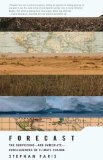Summary | Excerpt | Reviews | Beyond the Book | Readalikes | Genres & Themes | Author Bio
The Consequences of Climate Change, from the Amazon to the Arctic, from Darfur to Napa Valley

Critics' Opinion:
Readers' Opinion:
First Published:
Dec 2008, 256 pages
Paperback:
Sep 2009, 256 pages
 Book Reviewed by:
Book Reviewed by:
Beth Hemke Shapiro
Buy This Book
The name Darfur means “Land of the Fur,” called so for the largest single tribe of farmers in the region. But the vast region holds the homelands—the dars—of many tribes. In the late 1980s, landless and increasingly desperate Arabs banded together to wrest their own dar from the black farmers, publishing in 1987 a manifesto of racial superiority. It began with complaints of underrepresentation in the government and concluded with a threat to take matters into their own hands: “We fear that if this neglect of the participation of the Arab race continues, things will break loose from the hands of the wise men to those of the ignorant, leading to matters of grave consequences.”
Clashes had broken out between the Fur and camel-herding Arabs, and in the two years before an uneasy peace was signed in 1989, three thousand people, mostly Fur, were killed, and hundreds of villages and nomadic camps were burnt. More fighting in the 1990s entrenched the divisions between Arabs and non-Arabs, pitting the pastoralists against the Fur, Zaghawa, and Massaleit, the three tribes that would later form the bulk of the rebellion against the central government. In these disputes, Khartoum often supported the Arabs politically. Sometimes—in an attempt to create a bulwark against revolutionaries from southern Sudan—the government provided arms.
When a rebellion began in Darfur in 2003, it was at first a reaction against Khartoum’s neglect and political marginalization of the region. But while the rebels initially sought a pan-ethnic front against a distant, uncaring regime, the schism between those who opposed the government and those who supported it soon broke largely on ethnic lines. The camel-herding Arabs became Khartoum’s staunchest stalwarts.
Nomadic Arab militia launched a brutal campaign to push the black farmers from Darfur. They wore military uniforms, sometimes drove military vehicles, and coordinated their attacks with Sudanese aerial bombing. Even so, the conflict was rooted more in land envy than in ethnic hatred. “Some of the Arab pastoral tribes, particularly the camel herders, did not have their own dar, so were always at the mercy of other tribes for land,” said David Mozersky, the International Crisis Group’s project director for the Horn of Africa. “This was fine for hundreds of years, since the system provided land for these groups as they moved. But as desertification worsened and as fertile land decreased, some of these pastoralists sought to have their own land, which wasn’t really an option in Darfur. This was one of the main factors that Khartoum used to manipulate and mobilize these Arab tribes to join the Janjaweed and fight on their side. Interestingly, most of the Arab tribes who have their own land rights did not join the government’s fight.”
Excerpted from Forecast by Stephan Faris. Copyright © 2009 by Stephan Faris. Excerpted by permission of Macmillan, a division of Henry Holt and Company. All rights reserved. No part of this excerpt may be reproduced or reprinted without permission in writing from the publisher.





The Flower Sisters
by Michelle Collins Anderson
From the new Fannie Flagg of the Ozarks, a richly-woven story of family, forgiveness, and reinvention.

The House on Biscayne Bay
by Chanel Cleeton
As death stalks a gothic mansion in Miami, the lives of two women intertwine as the past and present collide.

The Funeral Cryer by Wenyan Lu
Debut novelist Wenyan Lu brings us this witty yet profound story about one woman's midlife reawakening in contemporary rural China.
Your guide toexceptional books
BookBrowse seeks out and recommends the best in contemporary fiction and nonfiction—books that not only engage and entertain but also deepen our understanding of ourselves and the world around us.